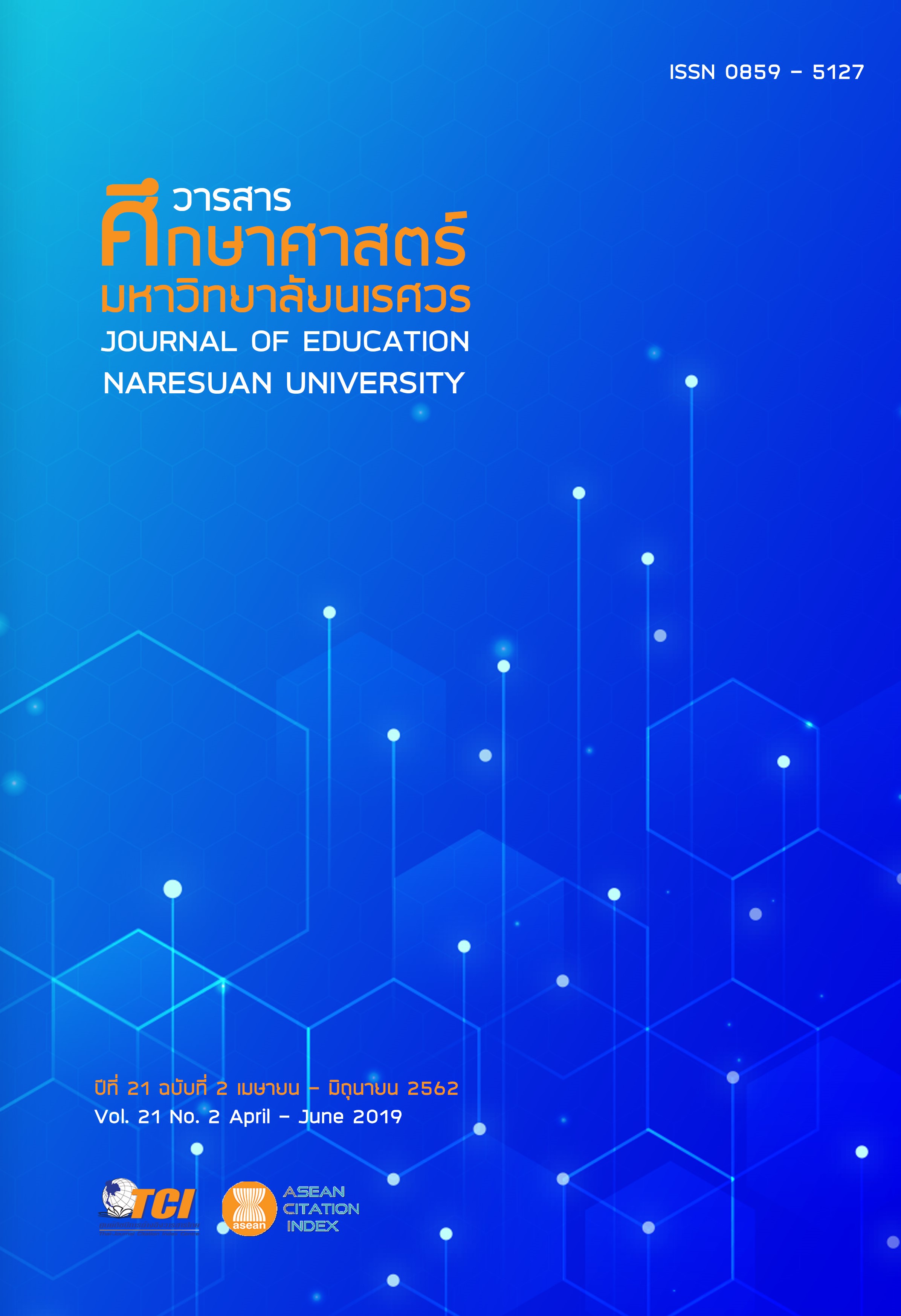การพัฒนารูปแบบการเรียนการสอนบนเครือข่ายอินเทอร์เน็ตแบบการเรียนรู้ด้วยการใช้แผนผังความคิดที่มีต่อการพัฒนาความคิดสร้างสรรค์ สำหรับนักศึกษาสาขาออกแบบผลิตภัณฑ์อุตสาหกรรม ระดับปริญญาตรี (DEVELOPMENT OF COLLABORATIVE LEARNING MODEL ON INTERNET BASED INSTRUCTION USING MIND MAP TO DEVELOP CREATIVE THINKING OF UNDERGRADUATE STUDENT INDUSTRIAL DESIGN PROGRAMME)
Main Article Content
Abstract
การวิจัยครั้งนี้มีจุดมุ่งหมายหลักเพื่อพัฒนารูปแบบการเรียนการสอนบนเครือข่ายอินเทอร์เน็ตแบบการเรียนรู้ด้วยการใช้แผนผังความคิดที่มีต่อการพัฒนาความคิดสร้างสรรค์ สำหรับนักศึกษาสาขาออกแบบผลิตภัณฑ์อุตสาหกรรม ระดับปริญญาตรี ที่ผ่านการประเมินรับรองจากผู้เชี่ยวชาญจำนวน 17 คน นำไปทดลองใช้กับผู้เรียนสาขาออกแบบผลิตภัณฑ์อุตสาหกรรม จำนวน 35 คน แบ่งเป็นกลุ่มทดลอง 18 คน และกลุ่มควบคุม 17 คน ผลการวิจัย พบว่า ผู้เรียนกลุ่มทดลองมีคะแนนความคิดสร้างสรรค์และผลการสร้างสรรค์ผลงานการออกแบบสูงขึ้น อย่างมีนัยสำคัญทางสถิติที่ระดับ .05 และความคิดสร้างสรรค์กับผลงานการออกแบบของนักศึกษามีความสัมพันธ์กันอย่างมีนัยสำคัญทางสถิติที่ระดับ .05 ผู้เรียนมีความพึงพอใจต่อการเรียนการสอนบนเครือข่ายอินเทอร์เน็ตแบบการเรียนรู้ด้วยการใช้แผนผังความคิดที่มีต่อการพัฒนาความคิดสร้างสรรค์อยู่ในระดับมาก
DEVELOPMENT OF COLLABORATIVE LEARNING MODEL ON INTERNET BASED INSTRUCTION USING MIND MAP TO DEVELOP CREATIVE THINKING OF UNDERGRADUATE STUDENT INDUSTRIAL DESIGN PROGRAMME
The objective of this research is to develop an online collaborative learning model by using mind map to develop creative thinking for undergraduate students of Industrial Design Program, which this model has been validated by the 17 experts from across the country. The participants of the study are 35 students in total, they were divided into 18 students of the experimental group, and 17 students of control group. The results illustrate that the experimental group has higher creative and design score, according to Torrance Tests, than the control group, with the statistical significance at .05. The score from the creative characteristics and from the designed works of the students are positively correlated with the statistical significance at .05 from satisfaction questionnaire, the experimental group is satisfied with the internet based collaborative learning using mind map to develop creative thinking at good level.
Article Details
The owner of the article does not copy or violate any of its copyright. If any copyright infringement occurs or prosecution, in any case, the Editorial Board is not involved in all the rights to the owner of the article to be performed.
References
2. Bamroongcheep, U. (2017). The student’s satisfaction upon of the information and communication technology for education systems services of the Faculty of Education Burapha University. Journal of Education Naresuan University, 19(1), 146-159. [in Thai]
3. Boonying, V. (2014). Thinking school. Journal of Education Naresuan University, 16(1), 180-183. [in Thai]
4. Boonvong, N. (1996). Principles of design. Bangkok: Chulalongkorn Uiversity Press. [in Thai]
5. Buzan, T., & Buzan, B. (2004). The mind map book. London: BBC Books.
6. Chareonwongsak, K. (2006). Creative thinking. Bangkok: Success Media. [in Thai]
7. Chuntarasurin, N. (1999). A comparison of science learning achievement and creative thinking in science using concept mapping and conventional learning approaches for Mathayomsuksa II students at Prateap Vithayathan School in Saraburi province (Master thesis). Nonthaburi: Sukhothai Thammathirat Open University. [in Thai]
8. Coggle. (2016). Collaborative mind maps. Retrieved March 25, 2016, from https://coggle.it/
9. La-iad-on, P. (2008). Modern design process. A seminar on Process of Modern Industrial Product Design, Faculty of Industrial Technology Rajabhat Pibulsongkram University Phitsanulok. [in Thai]
10. Na-Songkhla, J. (2004). Web-based learning Design. Bangkok: Faculty of Education Chulalongkorn University. [in Thai]
11. Office of the National Economic and Social Development Board. (2017). The twelfth national economic and social development plan. Retrieved February 10, 2017, from https://www.nesdb.go.th [in Thai]
12. Permchart, S. (2008). The development of a web-based learning course model on Muaythai for higher education (Doctoral dissertation). Bangkok: Srinakharinwirot University. [in Thai]
13. Poovarawan, Y. (2005). Internet technology. Microcomputer, 23(241), 1. [in Thai]
14. Praevanich, P. (2000). A development of teaching model by using mind mapping to enhance nursing students' creative thinking ability (Doctoral dissertation). Bangkok: Chulalongkorn University. [in Thai]
15. Saiseesod, S. (2002). A development of Internet-based learning for Rajabhat Universities (Doctoral dissertation). Bangkok: Srinakharinwirot University. [in Thai]
16. Thavonrattanavanit, S. (1998). Effects of the mind mapping technique training on creative thinking of Prathomsuksa five students (Master thesis). Bangkok: Chulalongkorn University. [in Thai]
17. Tongdeelert, P. (2000). A proposed collaborative learning model on computer network-based learning for undergraduate students with difference learning styles (Doctoral dissertation). Bangkok: Chulalongkorn University. [in Thai]
18. Torrance, E.P. (1965). The torrance tests of creative thinking. Bensenville, IL: Scholastic 119 Testing Service.

